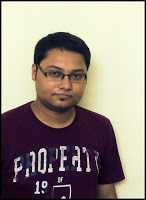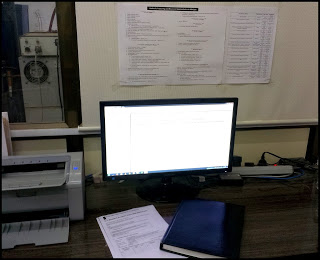I am Debanjan Guha Roy and This is How I Work
 Today, I am inviting Debanjan Guha Roy in the “How I Work” series. Debanjan has been working as a Ph.D student since 2013 at the IITB-Monash Research Academy, a joint venture between the Indian Institute of Technology Bombay (IIT Bombay), India and Monash University, Australia. His research topic is numerical and experimental modeling of the hydraulic fracture propagation. Apart from that he also has research interests in the geomechanics of the carbon dioxide sequestration and reservoir engineering. He holds a B.Sc degree in Geological Sciences from Jadavpur University (2011) and M.Sc degree in Applied Geology from IIT Bomby (2013). Both his B.Sc and M.Sc educations were supported by the Department of Science and Technology (DST)-INSPIRE fellowship. He is a recipient of Duncan A. McNaughton Grant from American Association of Petroleum Geologists (AAPG) and Star Fellowship from Society of Petroleum Engineers (SPE) during his Ph.D. He has been a national level coordinator of the “Energy Technology Vision 2035 student initiative”, 2012. This student initiative worked as a parallel body to the Technology and Information Forecasting Assessment Council (TIFAC) of Department Govt. of India working on the ‘Technology Vision 2030’.
Today, I am inviting Debanjan Guha Roy in the “How I Work” series. Debanjan has been working as a Ph.D student since 2013 at the IITB-Monash Research Academy, a joint venture between the Indian Institute of Technology Bombay (IIT Bombay), India and Monash University, Australia. His research topic is numerical and experimental modeling of the hydraulic fracture propagation. Apart from that he also has research interests in the geomechanics of the carbon dioxide sequestration and reservoir engineering. He holds a B.Sc degree in Geological Sciences from Jadavpur University (2011) and M.Sc degree in Applied Geology from IIT Bomby (2013). Both his B.Sc and M.Sc educations were supported by the Department of Science and Technology (DST)-INSPIRE fellowship. He is a recipient of Duncan A. McNaughton Grant from American Association of Petroleum Geologists (AAPG) and Star Fellowship from Society of Petroleum Engineers (SPE) during his Ph.D. He has been a national level coordinator of the “Energy Technology Vision 2035 student initiative”, 2012. This student initiative worked as a parallel body to the Technology and Information Forecasting Assessment Council (TIFAC) of Department Govt. of India working on the ‘Technology Vision 2030’.
Current Job: Dual-badged Ph.D candidate at Indian Institute of Technology Bombay (India) and Monash University (Australia)
Current Location: Mumbai, India
Current mobile device: HTC Desire 500
Current computer: Compaq
Can you briefly explain your current situation and research to us?
I am a third year reservoir geomechanics Ph.D candidate researching the hydraulic fracture propagation modeling. Due to the dual-badge and multidisciplinary nature of my research, I am being jointly supervised by faculties from Dept. of Earth Sciences (IIT Bombay) and Civil Engineering (Monash University). I am also a Teaching Assistant (TA) conducting Engineering Geology practical classes of the Applied Geology and Applied Geophysics masters’ students.
My work focuses on the experimental and numerical modeling of the hydraulic fracture propagation in the hydrocarbon bearing rocks. Hydraulic fracturing (or “Fracking”) is used extensively in oil and gas industry to stimulate wells and enhance oil and gas production. India, which is the fourth largest energy consumer in the world, holds nearly 500 to 2000 trillion cubic meters of shale gas across several sedimentary basins. And this huge resource can only be exploited using hydraulic fracturing. So my project aims to first establish the geomechanical and fracture properties of the hydrocarbon bearing reservoir rocks (e.g. – shale, sandstone) from India under different temperature, pressure and saturation conditions. These data will be then used to model the single and multiple fracture propagation in the reservoirs under varying geological conditions. The fracture propagation modeling will be done using the advance “Cohesive crack zone” technique under finite element method and extended-finite element framework. By doing so, we wish to come up with the critical findings related to the production capability of the hydrocarbon bearing basin, required pressure for the fracturing, geometry and growth pattern of the fractures etc.
What tools, apps and software are essential to your workflow?
I do majority of my work on my office PC. Dropbox is an indispensable tool for my research. I use Skype/GoToMeeting to hold regular meetings with my supervisor and research committee members in Australia. Most of my writings, presentations and data analyses are done using MS Office suite. I use Corel Draw to prepare the diagrams. Apart from data analysis, I use MS Excel extensively to keep a project overview, details of the journals and conferences and maintaining a back-up contact detail. I also regularly maintain a Lab journal, which is particularly useful during brain-storming ideas and reviewing past works. I use Google Tasks and Google calendar to make to-do lists and to maintain my schedules. I use Rapportive plug-in in Gmail; it helps to get quick professional details of the contacts in an email directly from their LinkedIn profile in the Gmail.
While working from my room, many times I use TeamViewer to access my lab computer. This is particularly useful for keeping an eye on the simulation running in the Lab computer.
What does your workspace setup look like?
I mostly work in my university lab, where I sit with other Ph.D students at different stages of their research. The environment is quite open and conductive. It is particularly helpful to have quick and impromptu meetings, and to reach out others for help. I try to keep my desk neat and clean, but somehow papers and other documents keep piling up. While conducting experiments, I keep some of my rock samples on my desk for quick measurements. I also have important notes, charts and tables regarding the project progress, experiments and simulations attached on the wall behind my office monitor for quick reference.
Here is a picture of my desk:
What is your best advice for productive academic work?
From my Ph.D experience, I have learnt that setting realistic goals and being persistent on the effort are particularly important to get meaningful research work done. It is also useful to have a hobby and maintain a support group (close friends) to get yourself re-energized after long hours in lab and to get help during the times of depression. And for students collaborating with different institutions, keeping all the stake holders regularly updated about the research progress is a must. It helps getting draft papers/manuscripts reviews quickly from all the authors.
How do you keep an overview of projects and tasks?
I use MS Excel to keep the overview of my PhD work as well as research objectives. This is periodically reviewed and updated with progress. On daily basis, I use Google Task and Google Calendar to make to-do list. Apart from them I use many virtual sticky notes on my lab PC.
Besides phone and computer, do you use other technological tools in work and daily life?
No.
Which skill makes you stand out as an academic?
Persistence is the skill that makes me stand out. Since, I do a multidisciplinary project which is mostly different from my background, so I need to learn many new things on my own within a short period time. Also I believe I’m very flexible and open to new ideas and that is very advantageous.
What do you listen to when you work?
I prefer complete silence during writing. But, during data analysis I listen to either instrumental music or songs of James Taylor and The Carpenters.
What are you currently reading? How do you find time for reading?
Reply: “Courage and Conviction: An Autobiography” by General Vijay Kumar Singh. I am a not so regular reader. I mostly read over the weekends.
Are you more of an introvert or extrovert? How does this influence your working habits?
I am an ambivert person. I love talking to people on the subjects I like, but I need some quiet time to get my thoughts together and to review my day.
What’s your sleep routine like?
I’m very strict about my seep routine. I go to bed at 11 p.m. and wake up at 5.30 a.m.
What’s your work routine like?
Since I’m an early morning bird, so I get much work done before getting caught in the daily ramblings. My day starts with checking my emails and twitter. It is followed by reading a book or writing a part of my ongoing paper. I try to reach my lab by 9-9.30 am and leave by 5.30-6 p.m. My evenings are varied in nature and mostly spent learning programming language or drawing doodles.
What’s the best advice you ever received?
It is not possible to be best at every possible thing. Better to choose only few things and try to be best in that.

